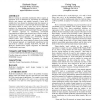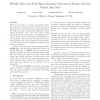303 search results - page 54 / 61 » Facial Expression Space Learning |
CVPR
2009
IEEE
15 years 2 months ago
2009
IEEE
The articulated body models used to represent human motion typically have many degrees of freedom, usually expressed as joint angles that are highly correlated. T...
CSB
2005
IEEE
14 years 1 months ago
2005
IEEE
In the feature selection of cancer classification problems, many existing methods consider genes individually by choosing the top genes which have the most significant signal-to...
SIGIR
2010
ACM
13 years 11 months ago
2010
ACM
Effective learning in multi-label classification (MLC) requires an ate level of abstraction for representing the relationship between each instance and multiple categories. Curren...
SDM
2007
SIAM
13 years 8 months ago
2007
SIAM
With recent advances in sensory and mobile computing technology, enormous amounts of data about moving objects are being collected. One important application with such data is aut...
ICCV
2007
IEEE
14 years 9 months ago
2007
IEEE
Many computer vision tasks may be expressed as the problem of learning a mapping between image space and a parameter space. For example, in human body pose estimation, recent rese...


